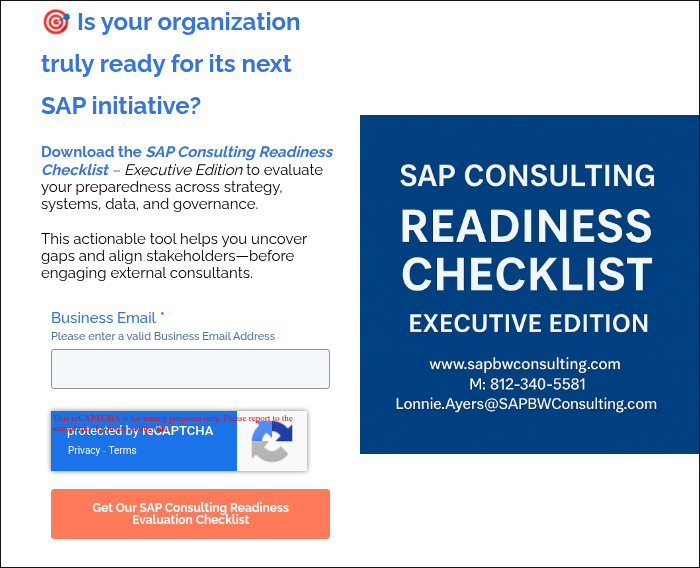Transform Your Business with Expert SAP Consulting Services

Lonnie D. Ayers
President and CEO

SAP Implementation Services
SAP Expert Implementation Services
Within our expertise with SAP Software Solutions and SAP Implementation Services, we recognize that for businesses to thrive and excel amidst today's cutthroat competition, they must strive for a competitive edge.
Business Transformation
That's why our focus lies in facilitating business transformation from your SAP investment. Our SAP Services support the critical process of instigating fundamental shifts in a company's operations, strategies, and structure to enhance its overall performance.
We hone in on four pivotal areas:
- Strategic Alignment: Through our SAP Implementation Services of SAP Solutions, we ensure that the desired business transformation aligns seamlessly with the company's long-term goals and objectives. Operational efficiency emerges as a paramount outcome, involving the streamlining of processes and workflows to amplify productivity and curtail waste.
- Cost Reduction: We deem cost reduction crucial, enabling businesses to trim expenses and allocate resources more judiciously. Leveraging an array of tools, techniques, and methodologies, our SAP Consulting Team works diligently to slash costs while concurrently improving your bottom line. SAP consulting companies are key players in on-going cost reduction efforts.
- Optimized Resource Allocation: Strategic distribution of resources, including time, money, and personnel, is imperative for optimal business performance and successful SAP implementation. By harnessing these key elements, our approach assists in crafting a winning business strategy that sets our clients apart from their competitors.
- Operational Efficiency Improvement: Identifying avenues where operational efficiencies can be bolstered, we delve deep into your financial statements, business intelligence systems, and subject matter expertise to unlock insights that drive improvement. With SAP Implementation Services at the forefront, we pave the way for transformative change that propels businesses toward sustained success.

Optimize Your Operations: SAP Business Process Analysis
SAP Business Process Analysis
In the realm of SAP implementations, meticulous planning and strategic analysis are paramount for success. One critical component of this process is SAP Business Process Analysis, a comprehensive examination of existing workflows and operations within an organization to identify opportunities for improvement and alignment with SAP solutions.
Follow SAP Best Practices
SAP Business Process Analysis plays a pivotal role in guiding the design and configuration of SAP systems, ensuring that they are tailored to meet the unique needs and objectives of the business. By adhering to best practices in Business Process Analysis, organizations can streamline operations, enhance efficiency, and maximize the value derived from their SAP investments.
SAP Business Process Analysis:
- Definition: SAP Business Process Analysis involves a thorough evaluation of existing business processes, including workflows, data flows, and decision-making pathways, to identify inefficiencies, redundancies, and areas for optimization.
- Role in SAP Projects: In SAP projects, Business Process Analysis serves as the foundation for system design and configuration. By gaining a deep understanding of how the organization operates, our SAP consultants can tailor SAP solutions to align seamlessly with business objectives and requirements.
- Importance of Best Practices: Following Best Practices in Business Process Analysis is crucial for designing an effective SAP system. By adhering to established methodologies and standards, organizations can ensure that their SAP implementation addresses key pain points, leverages industry-specific solutions, and promotes scalability and flexibility for future growth.
- Benefits: Through Business Process Analysis, organizations can streamline operations, eliminate bottlenecks, improve decision-making, and enhance overall business agility. By optimizing workflows and aligning processes with SAP capabilities, businesses can unlock new opportunities for innovation and competitive advantage.
Incorporating SAP Business Process Analysis into the early stages of a SAP project lays the groundwork for a successful implementation, setting the stage for improved efficiency, productivity, and business performance.
Streamline Your Enterprise: SAP ERP Implementation
SAP ERP Customization and Implementation
In the realm of SAP implementation, the quest for optimal system performance and alignment with business objectives begins with SAP ERP Customization. This tailored approach involves configuring SAP ERP solutions to suit the unique requirements and workflows of each organization.
SAP ERP Customization Best Practices
As a critical phase of the implementation process, SAP ERP Customization ensures that the SAP system seamlessly integrates with existing processes and drives efficiency gains across the enterprise. Adhering to SAP ERP Customization Best Practices is essential to harnessing the full potential of SAP solutions, mitigating risks, and maximizing return on investment.
SAP ERP Customization:
- Definition: SAP ERP Customization entails the adaptation of SAP ERP modules and functionalities to align with the specific needs and operational nuances of an organization.
- Role in SAP Projects: Customization is integral to tailoring SAP solutions to address unique business requirements and industry-specific challenges. By configuring SAP modules such as SAP Business Suite and SAP CRM to reflect organizational workflows, companies can optimize processes and enhance productivity.
- Importance of Best Practices: Following SAP ERP Customization Best Practices ensures that system modifications are executed in a structured and sustainable manner. By adhering to established guidelines and methodologies, organizations can minimize the risk of system disruptions, ensure data integrity, and facilitate seamless upgrades and expansions.
- Benefits: Through effective customization, organizations can achieve greater operational agility, improved decision-making capabilities, and enhanced user adoption of SAP solutions. By tailoring SAP ERP functionalities to meet specific business needs, companies can drive innovation, gain competitive advantage, and future-proof their operations.
Embracing SAP ERP Customization as a strategic enabler empowers organizations to unlock the full potential of their SAP investments, driving transformative change and sustained business growth.
SAP System Optimization
SAP System Optimization
In the dynamic landscape of SAP implementation, the pursuit of efficiency and performance optimization is paramount. At the core of this endeavor lies SAP System Optimization, a strategic initiative aimed at fine-tuning SAP systems to maximize operational effectiveness and deliver unparalleled business value. By embracing systematic analysis and refinement, organizations can unlock the full potential of their SAP investments, driving innovation and sustainable growth.
SAP System Optimization:
- Definition: SAP System Optimization encompasses a comprehensive review and enhancement of SAP systems to improve performance, scalability, and user experience.
- Role in SAP Projects: As an integral component of SAP projects, System Optimization ensures that SAP solutions evolve in tandem with evolving business needs and technological advancements. By fine-tuning system configurations and parameters, organizations can enhance system responsiveness, streamline processes, and drive innovation.
- Importance of Best Practices: Adhering to SAP System Optimization Best Practices is essential for safeguarding system stability, reliability, and security. By following established guidelines and methodologies, organizations can mitigate risks associated with system downtime, data corruption, and performance degradation, ensuring uninterrupted operations and seamless user experiences.
- Benefits: Through proactive System Optimization, organizations can realize tangible benefits such as improved system performance, enhanced user productivity, and reduced total cost of ownership (TCO). By optimizing system resources and configurations, companies can leverage SAP solutions as strategic assets to drive competitive advantage and achieve business objectives.
By prioritizing SAP System Optimization as a strategic imperative, organizations can stay ahead of the curve, driving continuous improvement and innovation to meet the evolving demands of the digital age.
SAP System Upgrades
Methodical SAP System Upgrades
As organizations navigate the ever-evolving landscape of SAP solutions, the concept of SAP System Upgrades emerges as a pivotal element in ensuring continued relevance, performance, and security.
Strategic Initiatives
These upgrades represent a strategic initiative aimed at enhancing system capabilities, addressing emerging business requirements, and leveraging the latest technological advancements to drive innovation and competitiveness.
SAP System Upgrades:
- Definition: SAP System Upgrades encompass the process of implementing new releases, patches, and enhancements to SAP systems to incorporate new features, functionalities, and security updates.
- Role in SAP Projects: Within the context of SAP projects, System Upgrades play a crucial role in ensuring that organizations stay current with the latest advancements and best practices in SAP technology. By proactively upgrading their SAP systems, businesses can capitalize on new capabilities, optimize performance, and mitigate risks associated with outdated software versions.
- Importance of Best Practices: Adhering to SAP System Upgrades Best Practices is imperative for minimizing disruptions, ensuring data integrity, and maximizing the return on investment in SAP solutions. By following established methodologies and guidelines, organizations can streamline the upgrade process, minimize downtime, and ensure compatibility with existing configurations and customizations.
- Benefits: Through systematic System Upgrades, organizations can unlock a myriad of benefits, including enhanced system performance, improved user experience, and strengthened security posture. By embracing the latest innovations and features offered by SAP, businesses can position themselves for sustained growth, agility, and competitiveness in an ever-changing marketplace.
By embracing SAP System Upgrades as a strategic imperative, organizations can future-proof their SAP investments, stay ahead of the curve, and unlock new opportunities for innovation and business transformation.
Seamless Connectivity: SAP System Integration
SAP Systems Integration
In the intricate eco-system of SAP solutions, the concept of SAP System Integration emerges as a linchpin for orchestrating seamless connectivity and interoperability across diverse systems and modules. This essential process involves the harmonious alignment of disparate elements within the SAP landscape, facilitating streamlined workflows, data exchange, and collaboration across functional areas and business processes.
SAP System Integration:
- Definition: SAP System Integration entails the amalgamation of various SAP modules, applications, and external systems to create a unified and cohesive ecosystem. Through integration, organizations can break down data silos, eliminate redundancies, and foster real-time information exchange to support informed decision-making and agile operations.
- Role in SAP Projects: Within SAP projects, System Integration serves as a fundamental enabler for realizing the full potential of SAP solutions. By seamlessly connecting diverse systems and modules, organizations can achieve end-to-end visibility, automate processes, and enhance data accuracy and consistency across the enterprise.
- Importance of Best Practices: Adhering to SAP System Integration Best Practices is essential for mitigating risks, ensuring system reliability, and maximizing the efficiency of integrated processes. By following established guidelines and standards, organizations can minimize data latency, prevent data corruption, and maintain data integrity throughout the integration lifecycle.
- Benefits: Through effective System Integration, organizations can unlock a plethora of benefits, including improved operational efficiency, enhanced agility, and accelerated time-to-market for new initiatives. By leveraging integrated data and processes, businesses can gain actionable insights, optimize resource allocation, and respond swiftly to changing market dynamics and customer demands.
By embracing SAP System Integration as a strategic imperative, organizations can transcend traditional boundaries, foster innovation, and lay the foundation for sustainable growth and competitive advantage in today's digital economy.
SAP System Migration
Migrating SAP Systems
Within the realm of SAP implementation, the notion of SAP System Migration emerges as a pivotal phase, representing the transition from legacy systems to modern SAP solutions.
Transformation Process
This transformative process involves the relocation of data, applications, and infrastructure to new SAP environments, facilitating enhanced functionality, scalability, and agility to meet evolving business needs and technological advancements.
SAP System Migration:
- Definition: SAP System Migration encompasses the comprehensive transfer of data, configurations, and functionalities from legacy systems to SAP platforms. It involves meticulous planning, execution, and validation to ensure seamless continuity of business operations and data integrity throughout the migration process.
- Role in SAP Projects: System Migration plays a foundational role in SAP projects, laying the groundwork for innovation, growth, and digital transformation. By migrating to SAP solutions such as SAP S/4HANA or SAP Business Suite, organizations can modernize their IT infrastructure, unlock new capabilities, and align with industry best practices to drive operational excellence.
- Importance of Best Practices: Adhering to SAP System Migration Best Practices is paramount for minimizing disruptions, mitigating risks, and maximizing the success of migration initiatives. By following established methodologies and guidelines, organizations can ensure data accuracy, preserve business continuity, and optimize performance in the new SAP environment.
- Benefits: Through effective System Migration, organizations can reap a multitude of benefits, including improved system performance, enhanced data visibility, and increased agility in responding to market dynamics. By consolidating disparate systems and leveraging SAP's advanced features, businesses can streamline operations, reduce costs, and position themselves for future growth and innovation.
By embracing SAP System Migration as a strategic imperative, organizations can embark on a journey of digital transformation, unlocking new possibilities, and propelling themselves toward sustained success in the ever-evolving landscape of enterprise technology.
SAP System Configuration
SAP System Configuration
At the heart of every SAP implementation journey lies the critical phase of SAP System Configuration, where the blueprint for system functionality and behavior is meticulously crafted. Unlike customization, which involves tailoring SAP solutions to specific business needs, system configuration focuses on setting parameters, defining workflows, and optimizing system settings to align with organizational requirements and industry best practices.
SAP System Configuration Outcomes:
- Definition: SAP System Configuration involves the initial setup and fine-tuning of SAP systems to ensure optimal performance, functionality, and alignment with business objectives. It encompasses defining system parameters, configuring modules, and establishing data structures to support business processes and workflows.
- Role in SAP Projects: System Configuration serves as the foundation for SAP projects, laying the groundwork for subsequent customization, integration, and optimization efforts. By defining system settings and parameters upfront, organizations can streamline implementation timelines, mitigate risks, and ensure seamless alignment with business requirements.
- Importance of Best Practices: Adhering to SAP System Configuration Best Practices is essential for maintaining system stability, scalability, and integrity throughout the implementation lifecycle. By following established guidelines and standards, organizations can minimize the risk of configuration errors, ensure data consistency, and facilitate easier maintenance and upgrades in the future.
- Differentiation from Customization: While customization involves tailoring SAP solutions to meet specific business needs, system configuration focuses on setting up standard functionalities and defining system behaviors within predefined parameters. Configuration typically involves selecting options from predefined lists, whereas customization may involve developing new functionalities or modifying existing ones.
- Benefits: Through effective System Configuration, organizations can realize numerous benefits, including improved system performance, enhanced user experience, and reduced time-to-value for SAP implementations. By optimizing system settings and workflows, businesses can drive efficiency, productivity, and agility across the enterprise.
By embracing SAP System Configuration as a cornerstone of their SAP implementation strategy, organizations can lay a solid foundation for success, ensuring that their SAP systems are finely tuned to support business objectives and drive continuous improvement.
SAP System Training
SAP System Training
Amidst the intricate tapestry of SAP implementation, the significance of SAP System Training shines as a beacon of empowerment and proficiency. This indispensable component entails equipping end-users and project team members with the knowledge, skills, and insights needed to harness the full potential of SAP solutions, drive operational excellence, and achieve strategic objectives.
SAP Training Methodology
By embracing systematic training methodologies and best practices, organizations can foster a culture of learning and innovation, paving the way for sustainable success in the digital age.
SAP System Training:
- Definition: SAP System Training encompasses the structured delivery of educational programs and resources aimed at familiarizing end-users and project team members with SAP systems, functionalities, and best practices. It equips participants with the requisite skills and competencies to navigate SAP applications confidently, execute tasks efficiently, and leverage SAP solutions to drive business outcomes.
- Role in SAP Projects: Training plays a pivotal role in SAP projects, ensuring that stakeholders across the organization are equipped to embrace change, adopt new processes, and maximize the value derived from SAP investments. By providing comprehensive training programs tailored to different user roles and proficiency levels, organizations can facilitate smooth transitions, minimize resistance to change, and accelerate user adoption of SAP solutions.
- Importance of Best Practices: Adhering to SAP System Training Best Practices is crucial for optimizing learning outcomes, maximizing retention, and ensuring long-term proficiency with SAP systems. Best practices may include personalized learning paths, hands-on exercises, role-based training modules, and ongoing support mechanisms to address evolving user needs and challenges.
- Differentiation from Project Team Member Training: End-user training focuses on equipping individuals across the organization with the skills needed to perform day-to-day tasks within the SAP system. In contrast, project team member training encompasses specialized training sessions tailored to the unique roles and responsibilities of project stakeholders, including SAP consultants, project managers, and business analysts. While end-user training emphasizes system navigation and task execution, project team member training delves deeper into system configuration, customization, and project management methodologies.
Through strategic investment in SAP System Training, organizations can empower their workforce, foster innovation, and unlock the full potential of SAP solutions to drive sustainable growth and competitive advantage.
24/7 Expert SAP Support: Keep Your Business Running Smoothly
SAP Support Approach
Amid the intricate framework of SAP implementation, the concept of SAP Support emerges as a cornerstone for ensuring system reliability, performance, and user satisfaction. This essential service encompasses a comprehensive array of resources, tools, and methodologies aimed at addressing technical issues, resolving challenges, and optimizing the functionality of SAP systems.
Systematized Support Practices
By embracing systematic support practices and leveraging the power of SAP Solution Manager, organizations can nurture a culture of continuous improvement and innovation, driving sustained value and success.
SAP Support:
- Definition: SAP Support entails the provision of ongoing assistance, guidance, and troubleshooting services to address technical issues, optimize system performance, and maximize user productivity within SAP environments. It encompasses a range of support channels, including help desk support, remote assistance, and knowledge base access, to ensure timely resolution of issues and seamless operation of SAP systems.
- Role in SAP Projects: Support plays a vital role in SAP projects, providing a lifeline for users and administrators alike as they navigate the complexities of SAP solutions. From system configuration to post-implementation support, SAP Support ensures that organizations can leverage SAP systems to their fullest potential, driving operational efficiency and achieving strategic objectives.
- Importance of Best Practices: Adhering to SAP Support Best Practices is essential for maintaining system stability, reliability, and performance over the long term. Best practices may include proactive system monitoring, regular maintenance activities, and adherence to service level agreements (SLAs) to ensure timely resolution of issues and minimize downtime.
- SAP Solution Manager: The SAP Solution Manager serves as a central hub for managing and delivering SAP Support services. It offers a comprehensive suite of tools and functionalities for system monitoring, incident management, and performance optimization, empowering organizations to streamline support processes, enhance visibility, and drive continuous improvement across the SAP landscape.
- Hyper-Care Support: Post go-live, organizations often engage in Hyper-Care support, a specialized form of support that offers intensive assistance and guidance during the critical initial stages of system operation. Integrated seamlessly with SAP's overall support approach and delivered in collaboration with partners, Hyper-Care support ensures a smooth transition to live operations, addresses user concerns, and fosters confidence in SAP solutions.
By embracing SAP Support as a strategic imperative, organizations can nurture a resilient and responsive IT ecosystem, empowering users, driving innovation, and unlocking the full potential of SAP solutions to fuel growth and competitive advantage.
SAP Continuous Business Improvement Phase
Better Every Day
At the heart of SAP's commitment to driving innovation and value lies the concept of the SAP Continuous Business Improvement Phase, a strategic initiative aimed at fostering a culture of ongoing evolution, optimization, and innovation within organizations leveraging SAP solutions.
SAP Customer Engagement Lifecycle
This phase, nestled within the broader SAP Customer Engagement Lifecycle, serves as a catalyst for identifying opportunities, driving operational excellence, and unlocking new avenues for growth and competitiveness.
SAP Continuous Business Improvement Phase:
- Definition: The SAP Continuous Business Improvement Phase embodies a structured approach to iteratively assess, refine, and enhance business processes, workflows, and systems leveraging SAP solutions. It involves ongoing analysis, feedback collection, and iteration to identify inefficiencies, address pain points, and capitalize on emerging opportunities for improvement.
- Role in SAP Projects: The Continuous Business Improvement Phase serves as a pivotal component of SAP projects, ensuring that organizations can adapt, evolve, and thrive in dynamic business environments. By embracing a culture of continuous improvement, organizations can harness the full potential of SAP solutions, drive operational efficiency, and stay ahead of the curve in an ever-changing marketplace.
- Importance of Best Practices: Adhering to the SAP Continuous Business Improvement Phase "Best Practices" is paramount for maximizing the value and impact of improvement initiatives. Best practices may include establishing clear objectives and key performance indicators (KPIs), fostering collaboration and knowledge sharing across departments, and leveraging data analytics and insights to drive informed decision-making and prioritize improvement efforts.
- Integration with SAP Customer Engagement Lifecycle: The Continuous Business Improvement Phase seamlessly integrates with the broader SAP Customer Engagement Lifecycle, serving as a feedback loop for identifying value, driving customer success, and building a compelling business case for subsequent SAP projects. By continually assessing and addressing evolving business needs and market dynamics, organizations can drive sustained value and return on investment from their SAP implementations.
By embracing a SAP Continuous Business Improvement Phase as a strategic imperative, organizations can foster a culture of innovation, agility, and excellence, positioning themselves for long-term success and competitiveness in the digital era.
Featured Articles
Project Management
Transformation
SAP BW Tutorial On Stakeholder Best Practices
Strategy
Business Consulting
Balanced Scorecard Strategy Management
Ecommerce
Request a Free SAP Consultation
In order to see if we are the right fit for your business, schedule a call with one of our strategists.

Customer Testimonials

Mohamadh Jameel MGB, Inspirational Leader & Coach | Helping SAP Run SmarterUnited Arab Emirates
Lonnie is a very experienced professional in Aerospace & Defence with lot of skills on maintenance & business processes in the industry. He also is a very excellent colleague to work with, as he shares his knowledge and always willing to help out. "Wish him success"

Francisco Verdesoto, SAP® S/4HANA Certified Consultant with Settlement Management, Vistex®, & Logistics Solution Delivery Lead and ArchitectGreater Minneapolis-St. Paul Area
Lonnie, a proven top class project manager and SAP proffesional, performed with excellence and showed superior leader qualities at VSuarez which is one of the largest and most challenging SAP projects in the history of Puerto Rico.
Would love to work with Lonnie again!

SAP Sr Consultant, Supermanzana 2 Centro, Quintana Roo, Mexico
Lonnie is an excellent PM & BW Consultant. He has a great personality and deep PM & BW Skills and I am glad to work with him on 2 projects (VSuarez like PM and Cemex like BI).
Featured in






